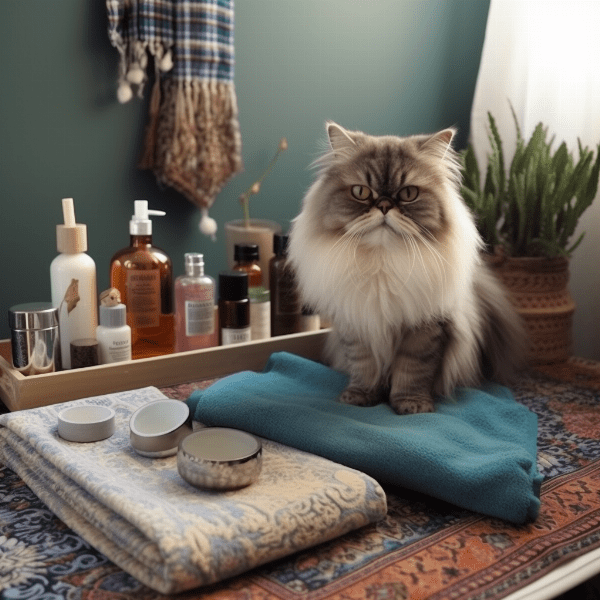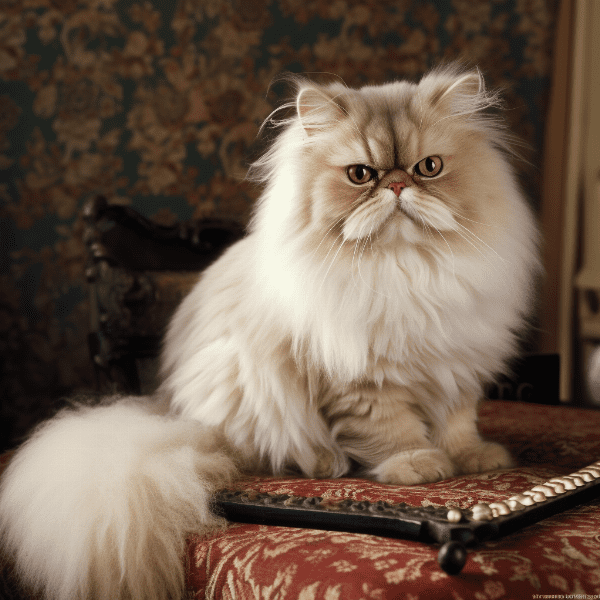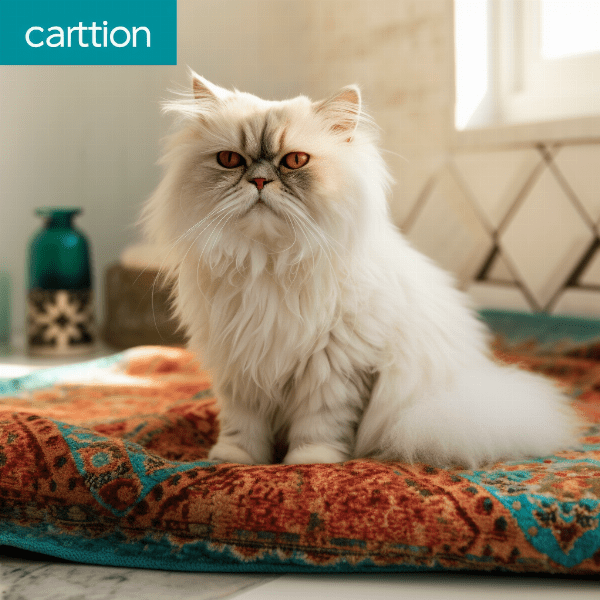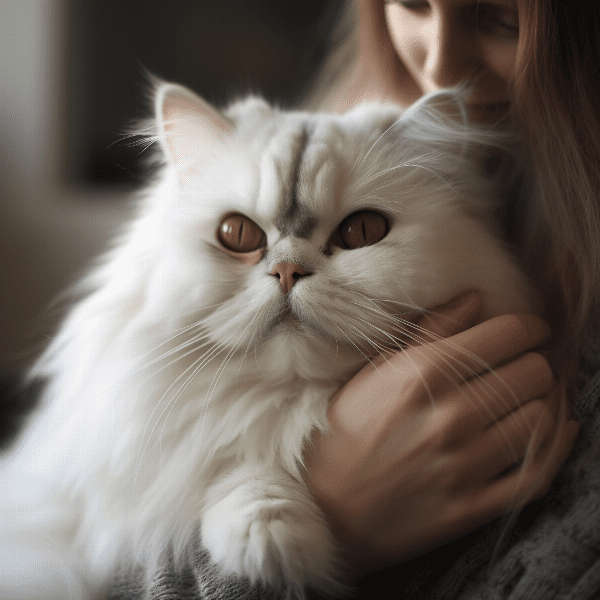Table of Contents
- Understanding the Persian Cat Coat
- Preparing for the Bathing Process
- Choosing the Right Shampoo for Your Persian Cat
- Step-by-Step Guide to Bathing Your Persian Cat
- Drying and Brushing Your Persian Cat After Bathing
- Dealing with Potential Challenges During the Bathing Process
- Frequency of Bathing Your Persian Cat
- Tips for Maintaining Your Persian Cat’s Coat Between Baths
- Common Mistakes to Avoid When Bathing Your Persian Cat
- Conclusion: The Benefits of Proper Persian Cat Bathing Techniques
Understanding the Persian Cat Coat
Persian cats are known for their luxurious, long, and fluffy coats. Their fur requires regular grooming and maintenance to keep it healthy and shiny. Understanding the characteristics of a Persian cat’s coat is essential for proper grooming and bathing techniques.
Characteristics of a Persian Cat’s Coat
The Persian cat breed is known for its long, thick, and silky coat. Persian cats come in a variety of coat colors and patterns, including solid, shaded, and bi-color. Their coat is composed of two layers of fur: a long and dense undercoat and a long and fine topcoat. The undercoat provides insulation, while the topcoat protects the cat from environmental factors such as water and wind.
Importance of Grooming for a Persian Cat’s Coat
Grooming is critical for a Persian cat’s coat health. Regular brushing and combing help remove dirt, debris, and loose hair, preventing matting and tangles. Proper grooming also stimulates blood flow and distributes natural oils throughout the coat, keeping it soft and shiny.
Common Coat Issues for Persian Cats
Despite their beauty, Persian cats are prone to several coat issues. Hairballs and matting are common problems due to their long fur. Skin issues such as dryness, flakiness, and fungal infections can also occur if proper grooming techniques are not followed. Additionally, Persian cats are more prone to shedding than other cat breeds, so regular grooming is essential to keep shedding under control.
Understanding the characteristics and needs of a Persian cat’s coat is the first step in proper grooming and bathing techniques. By maintaining their coat’s health, you can keep your Persian cat looking and feeling their best.

Preparing for the Bathing Process
Bathing a Persian cat can be a challenging task. However, with proper preparation, you can make the process easier for both you and your cat. Here are some essential steps to take before the bathing process:
Gather the Necessary Supplies
Before starting the bathing process, gather all the necessary supplies. You will need cat shampoo, towels, a non-slip mat, a pitcher, and a brush or comb. Make sure the shampoo is specifically formulated for cats, as human shampoo can be too harsh and cause skin irritation.
Trim Your Cat’s Nails
Trimming your cat’s nails before bathing is essential to avoid accidental scratches. Use a proper nail trimmer and make sure to cut only the tip of the nail, avoiding the quick, which is the sensitive part of the nail.
Choose the Right Location
Choose a location for bathing that is quiet, warm, and easy to clean. A bathroom or a large sink can be ideal places for bathing your Persian cat. Place a non-slip mat in the tub or sink to prevent your cat from slipping and hurting themselves.
Brush Your Cat’s Coat
Before bathing, brush your Persian cat’s coat thoroughly to remove any mats or tangles. Mats can become tighter when wet, making it harder to remove them after bathing. Brushing also helps remove loose hair, making the bathing process more comfortable for your cat.
Preparing for the bathing process is essential to ensure a successful and stress-free experience for both you and your Persian cat. By gathering the necessary supplies, trimming their nails, choosing the right location, and brushing their coat, you can set your cat up for a successful bath.

Choosing the Right Shampoo for Your Persian Cat
Choosing the right shampoo is essential when it comes to bathing your Persian cat. The wrong shampoo can cause skin irritation, dryness, and even hair loss. Here are some essential factors to consider when selecting a shampoo for your Persian cat:
pH Balance
A cat’s skin has a different pH balance than human skin. Therefore, using a shampoo specifically formulated for cats is crucial. Look for a shampoo that has a pH balance close to your cat’s skin to avoid irritation.
Scent
While scented shampoos may smell pleasant to humans, they can be overpowering for cats. Avoid shampoos with strong fragrances, as they can cause discomfort and even respiratory problems for your cat.
Ingredients
When selecting a shampoo for your Persian cat, avoid products that contain harsh chemicals and artificial additives. Look for shampoos that contain natural ingredients such as oatmeal, aloe vera, and chamomile, which can soothe and moisturize your cat’s skin.
.

Step-by-Step Guide to Bathing Your Persian Cat
Bathing a Persian cat can be a daunting task, but with the right techniques and approach, you can make the process less stressful for both you and your cat. Here is a step-by-step guide to bathing your Persian cat:
Step 1: Wet Your Cat’s Coat
Gently wet your cat’s coat using lukewarm water. Avoid spraying water directly on their face and ears, and instead, use a wet washcloth to clean these areas.
Step 2: Apply Shampoo
Apply a small amount of shampoo to your cat’s coat, focusing on the areas that are dirtiest or greasiest. Massage the shampoo into the coat, but avoid scrubbing too hard to prevent matting.
Step 3: Rinse Thoroughly
Rinse your cat’s coat thoroughly with lukewarm water, making sure to remove all the shampoo. Residue left on the coat can cause skin irritation and itching.
Step 5: Brush the Coat
Once your cat’s coat is dry, use a brush or comb to remove any remaining tangles or mats. Brushing also helps distribute natural oils throughout the coat, keeping it soft and shiny.

Drying and Brushing Your Persian Cat After Bathing
After bathing your Persian cat, proper drying and brushing are essential to maintain their coat’s health and appearance. Here are some essential steps to follow for drying and brushing your Persian cat after a bath:
Step 1: Use a Towel
Use a clean, dry towel to gently pat your cat’s coat dry. Avoid rubbing too hard, as this can cause matting and tangling.
Step 2: Use a Blow Dryer (Optional)
If your cat is comfortable with it, you can use a blow dryer set to the lowest heat setting to dry their coat. Keep the dryer at least 6 inches away from your cat’s coat and avoid directing the airflow directly onto their face and ears.
Step 3: Brush the Coat
Once your cat’s coat is dry, use a brush or comb to remove any tangles or mats. Start at the top of the head and work your way down to the tail, using long, gentle strokes. Pay special attention to areas prone to matting, such as under the legs and around the neck.
Step 4: Apply Conditioning Spray (Optional)
Applying a conditioning spray can help keep your cat’s coat soft and shiny. Choose a spray that is specifically formulated for cats and avoid products that contain artificial fragrances or chemicals.
Step 5: Reward Your Cat
Reward your cat with treats or playtime to create a positive association with the grooming process. This can make future grooming sessions more comfortable and stress-free for both you and your cat.
Drying and brushing your Persian cat after a bath is essential to keep their coat healthy and beautiful. By following these steps and taking the necessary precautions, you can ensure a successful and comfortable grooming experience for both you and your cat.

Dealing with Potential Challenges During the Bathing Process
Bathing a Persian cat can be a challenging task, and there may be potential challenges you need to overcome to ensure a successful and stress-free experience. Here are some potential challenges you may face during the bathing process and how to deal with them:
Challenge 1: Your Cat Is Nervous or Agitated
Persian cats can be nervous or agitated during the bathing process, which can make it challenging to keep them calm. To ease their anxiety, use a soothing and reassuring tone of voice, and give them plenty of positive reinforcement and treats.
Challenge 2: Your Cat Is Resisting the Bath
If your cat is resisting the bath, try to remain calm and patient. Avoid forcing your cat into the water and instead, use a pitcher or spray bottle to wet their coat gradually. Consider enlisting the help of a second person to hold your cat while you bathe them.
Challenge 3: Your Cat Has Matted Fur
Matted fur can be a significant challenge during the bathing process. Before bathing, use a brush or comb to remove as many mats as possible, as they can become tighter when wet. If the mats are severe, consider taking your cat to a professional groomer to avoid causing discomfort or skin irritation.
Challenge 4: Your Cat Is Not Drying Properly
If your cat’s coat is not drying properly, consider using a blow dryer on the lowest heat setting, or let them air dry in a warm and dry room. Avoid exposing them to cold drafts or direct heat sources, as this can cause discomfort or even illness.
Dealing with potential challenges during the bathing process requires patience, care, and a positive attitude. By staying calm and following these tips, you can help ensure a successful and stress-free bathing experience for both you and your Persian cat.

Frequency of Bathing Your Persian Cat
The frequency of bathing your Persian cat depends on several factors, such as their coat type, lifestyle, and health. Here are some essential factors to consider when determining how often to bathe your Persian cat:
Coat Type
The length and thickness of your cat’s coat play a significant role in how often they need to be bathed. Persian cats with long and thick coats require more frequent bathing than those with short and smooth coats. Long-haired cats can become dirty and greasy quickly and are more prone to matting and tangling.
Lifestyle
Your cat’s lifestyle can also affect their bathing frequency. If your cat spends most of their time indoors and is not exposed to dirt, dust, or other environmental factors, they may not need frequent baths. However, if your cat spends time outdoors or has access to a litter box, they may require more frequent baths to keep their coat clean and healthy.
Health
If your cat has skin allergies, fungal infections, or other health conditions, they may require more frequent baths to manage their symptoms. However, too frequent bathing can also cause dryness and irritation, so it’s essential to consult with your veterinarian to determine the best bathing frequency for your cat’s specific condition.
In general, most Persian cats only require bathing every four to six weeks, as frequent bathing can strip their coat of natural oils and cause dryness and skin irritation. However, factors such as coat type, lifestyle, and health should be considered when determining the ideal frequency for your cat. By maintaining proper grooming and hygiene, you can keep your Persian cat’s coat healthy and beautiful.

Tips for Maintaining Your Persian Cat’s Coat Between Baths
Maintaining your Persian cat’s coat between baths is crucial to ensure their health and appearance. Here are some essential tips to help you maintain your cat’s coat between baths:
Regular Brushing
Regular brushing is essential to prevent matting and tangling, remove loose hair, and distribute natural oils throughout your cat’s coat. Brush your cat’s coat at least once a day, using a comb or brush designed for long-haired cats.
Wipe Down Your Cat’s Coat
Wiping down your cat’s coat with a damp cloth or pet wipe can help remove dirt and debris, keeping their coat clean and shiny. Focus on areas that are prone to getting dirty, such as the face and paws.
Use a Detangling Spray
If your cat’s coat is prone to matting and tangling, consider using a detangling spray between baths. Choose a spray that is specifically formulated for cats and avoid products that contain harsh chemicals or artificial fragrances.
Monitor Your Cat’s Diet
A balanced diet is essential for your cat’s overall health, including their coat health. Make sure your cat is getting proper nutrition and consider adding supplements, such as omega-3 fatty acids, to their diet to promote healthy skin and coat.
Keep Your Cat Hydrated
Proper hydration is also crucial for your cat’s coat health. Make sure your cat has access to clean and fresh water at all times, and consider adding wet food to their diet to increase their water intake.
Maintaining your Persian cat’s coat between baths requires regular grooming, proper nutrition, and hydration. By following these tips, you can help ensure your cat’s coat remains healthy and beautiful between baths.

Common Mistakes to Avoid When Bathing Your Persian Cat
Bathing a Persian cat can be challenging, and there are several common mistakes that cat owners should avoid to ensure a successful and stress-free experience. Here are some common mistakes to avoid when bathing your Persian cat:
Mistake 1: Using the Wrong Shampoo
Using the wrong shampoo can cause skin irritation, dryness, and even hair loss. Avoid using human shampoo or products that contain harsh chemicals and artificial additives. Use a shampoo that is specifically formulated for cats and contains natural ingredients.
Mistake 2: Bathing Too Frequently
Bathing your Persian cat too frequently can strip their coat of natural oils and cause dryness and skin irritation. Most Persian cats only require bathing every four to six weeks, and factors such as coat type, lifestyle, and health should be considered when determining the ideal frequency for your cat.
Mistake 3: Forgetting to Rinse Thoroughly
Failing to rinse your cat’s coat thoroughly can cause skin irritation and itching. Make sure to remove all the shampoo residue from your cat’s coat and avoid leaving any product behind.
Mistake 4: Scrubbing Too Hard
Scrubbing too hard can cause matting and tangling, which can be challenging to remove. Avoid scrubbing too hard when applying shampoo or drying your cat’s coat.
Mistake 5: Not Preparing Properly
Not preparing properly can make the bathing process more challenging for both you and your cat. Make sure to have all the necessary supplies ready before starting, including shampoo, towels, and a brush or comb. Also, ensure the bathing area is safe and secure, and your cat cannot escape.
By avoiding these common mistakes, you can ensure a successful and stress-free bathing experience for both you and your Persian cat. Remember to stay calm and patient, and always prioritize your cat’s safety and comfort.

Conclusion: The Benefits of Proper Persian Cat Bathing Techniques
Promotes Coat Health
Regular bathing and grooming can help keep your cat’s coat healthy and free from matting, tangling, and other issues. Brushing your cat’s coat regularly can also help distribute natural oils, promoting a soft and shiny coat.
Prevents Skin Irritation and Infections
Bathing your Persian cat regularly can help prevent skin irritation and infections. Removing dirt, debris, and bacteria from your cat’s coat can reduce the risk of skin issues, such as fungal infections and hot spots.
Promotes Bonding and Trust
Bathing your Persian cat can also help promote bonding and trust between you and your cat. By approaching the process calmly and patiently and rewarding your cat with treats and positive reinforcement, you can create a positive association with the experience.
Detects Health Issues
Regular bathing and grooming can also help you detect any health issues your cat may have. During the bathing process, you can inspect your cat’s skin for any abnormalities, such as lumps, bumps, or rashes. Catching health issues early can lead to better outcomes and treatment options.
Proper Persian cat bathing techniques are essential to keep your cat healthy and happy. By following the steps outlined in this guide and avoiding common mistakes, you can ensure a successful and stress-free bathing experience for both you and your cat.




